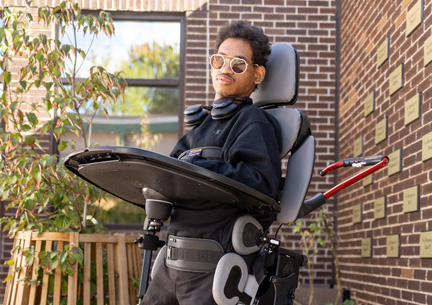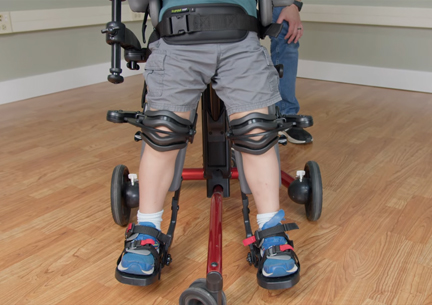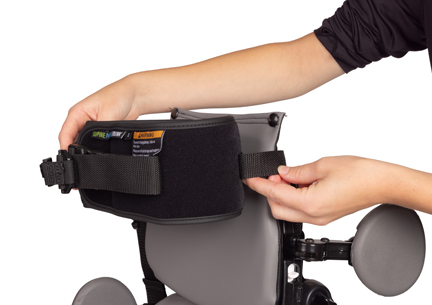Tips and Tricks for Getting More Out of Your Rifton TRAM
Standing and Walking in the School Setting
| April 2018
The Rifton TRAM provides a lot of flexibility within our school setting for standing, walking, and transfers. Mostly it is used for safe transfers that would typically require a two-person lift. However, in one of my schools it has provided a great solution for two students who needed more flexibility in their standing and walking routines at school. Here are two examples:
Case 1: This student has a diagnosis of spastic quadriplegic cerebral palsy. He spends most of his day in a custom molded seating system in his wheelchair. As he has gotten older he does not tolerate lying on the mat table as a change of position. He has poor trunk control and fair head control. When he first came to high school he used a Bronco stander for weight bearing opportunities at school and to change positions during his day, but he quickly became too tall for that stander. When I started looking at other options for standers I looked at one that moves from a sitting to standing position. Unfortunately, all of the options involved an anterior knee pad that put pressure on his knees, which was uncomfortable for him. The TRAM offered a perfect alternative for him for standing because he could slowly move from sitting to standing without any external pressure on his knees. The TRAM also provides the flexibility to increase or decrease how straight his knees are depending on how he is feeling that day. Here’s the procedure we use:
- Place the pelvic support on the edge of the mat table
- Two-person lift from his wheelchair to the edge of the mat table (it is difficult to get the body support system around him with his specific custom molded seating system and a two-person transfer is still a safe option.)
- Buckle the body support system and attache the pelvic positioner.For this student we attach the front straps for the pelvic positioner to the grey clips and the back straps to the red clips.
- We then slowly raise him up to a standing position and straps are adjusted as needed
- After standing for a couple of minutes we are able to raise the TRAM a little more because his legs will relax and he can tolerate more extension
- When he is ready to sit back down we reverse the process
Case 2: This student recently had orthopedic surgery. He was ambulatory with a crouched gait prior to surgery. After surgery he was non-weight bearing for several weeks. He is currently working on regaining his ability to stand and walk without support. The TRAM has offered a way to work on both weight bearing and walking without using two different pieces of equipment. He is easily transferred into the TRAM from his wheelchair. The hip positioner is used to support him in standing and walking. When he is working on weight bearing the TRAM is kept in a lower position so his legs are bent and he can push through them to stand. When he is working on walking the TRAM is raised so his legs are straighter to encourage an upright gait pattern. Here’s the procedure we use:
- Attach the hip positioner to the yellow clips at the front of the TRAM and let it hang down
- Remove the foot rests from the wheelchair
- Pull the TRAM up to the wheelchair
- The student assists pushing up into a standing position with an adult supporting on either side of him
- We pull the hip positioner through the legs of the student and attach it to the grey clips.
- If we are working on pushing through the legs to stand, we raise the TRAM up so his feet are on the ground but his knees are still a little bent
- If we are working on walking with his knees a little straighter, then we raise the TRAM up a little higher so both feet are on the ground but there is only a slight bend in the knee.




